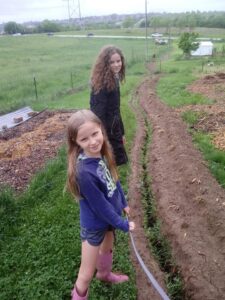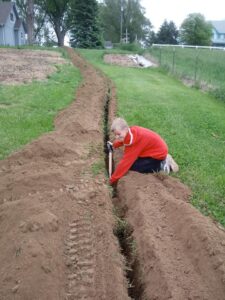Final report for FNC20-1226
Project Information
As small-scale, urban producers, we raise free-range chickens and nutrient-dense produce. We emphasize a low carbon footprint approach and good stewardship of our animals, the soil, and the earth. My wife and I purchased our property six years ago. It is 3.5 acres located on the edge of a sprawling city. The property had been neglected. At the time of purchase, it was overrun with invasive weeds and volunteer trees. Erosion was rampant. There were no fences. There were no gardens. It was sparse and daunting, but it was the beginning of a lifechanging adventure in small-scale, intensive, sustainable, agriculture. It was the start of our dream of feeding people healthy food.
Since we bought our property, we have worked tirelessly to restore its vitality. Up until October 2019, our efforts were focused exclusively on infrastructure and soil development. We have remedied the erosion and weed issues. We have fenced the property into paddocks which we graze rotationally. We have improved soil health through cover cropping, crop diversity, organic amendments, remineralization, deep mulching, and composting. We have hosted groups of kids from the public elementary school that abuts the rear of our property, taking them on educational walks around our farm. We have accepted the chicks they have hatched in the classroom, and we have worked with them to collect food waste from their school lunches to compost it on our property.
We have built chicken coops and flocks to go in them. We have built an orchard, a pumpkin patch, berry patches, and vegetable plots that produce a large variety of vegetables. We take a holistic approach and attempt to work with nature, not against it. For example, we placed a coop within the orchard to build a more natural habitat for the chickens that closely mimics their origins as jungle birds while also maximizing their usefulness with regard to fertilization and pest control.
After almost six years of development, in October 2019 we were finally producing enough to sell. We formed an LLC, Omaha’s High Ground: A Healthy Market Garden. We have started selling produce and eggs, and with a solid foundation in place, we are now seeking an opportunity to expand our customer base and to draw more people to our farm for education and re-connection with their food’s place of origin. Both my wife and I were classroom teachers, and even though we have left the classroom, we still eagerly embrace the opportunity to have customers and other growers out to our property to build understanding and enthusiasm for local, sustainable agriculture.
As small-scale, urban producers, we raise free-range chickens and nutrient-dense produce. We emphasize a low carbon footprint approach and good stewardship of our animals, the soil, and the earth. The problem we face is the question of how to responsibly increase customer base and profitability in a way that is aligned with these core values. For example, most modern marketing approaches can draw customers from across town, producing emissions. Therefore, to align with our beliefs, our expansion needs to draw customers who already pass our property on a daily commute.
The front of our property abuts a major urban thoroughfare. The opportunity is there. However, city code does not allow new construction close to that busy road, and costs are prohibitive (i.e. concrete pad and footings). City code also does not allow the construction of a business occupancy in a “Residential Zone.” Code does allow, however, sales from a roadside stand.
Therefore, to increase exposure in an environmentally friendly way, and to fall within code compliance, we will build a sales trailer to catch new customers as they pass, thereby reducing emissions and costs of shipping, while also drawing people in for on-sight educational classes.
Track increase in new customer sales generated by the high visibility of the trailer and its associated signage.
Track increase in educational outreach opportunities by monitoring farm visits generated by the high visibility of the trailer.
Reach out to other organic producers with less ideal locations to offer to sell their products. If we find interested producers, we will track the increase in revenue this high visibility outlet generates for them.
Share our experiences and findings in public forums such as presentations to our Local Foods Coordinating Council and through social media, an online video, and a farm field day.
Research
As stated earlier, our major objective with the trailer is to increase customer base. As an urban producer, we need to capitalize upon one of our greatest assets, our location. We need to increase our exposure and accessibility, thereby generating customers and educational outreach opportunities. Although it is true that many producers travel with trailers or booths to farmers’ markets, we are looking for a new approach, a new way to minimize this extra effort and its associated emissions, time commitment, and expenses: we are moving the market to the farm. Significantly, we are also focusing on reaching out to other organic producers who are in less-ideal locations, and we plan on offering to sell their products as well. Doing so will provide multiple informal, daily opportunities to discuss our successes and results with other producers, thereby benefiting all. Formally, we will also record the data that measures the trailer’s impact on sales, and we will share it with other producers and agencies such as the Local Foods Coordinating Council. We will share information on our trailer and associated operations online through social media, a Farm Field Day, and a final documentary video. Areas of specific interest will include, but not be limited to: utilization of the trailer to overcome restrictions and obstacles to direct marketing; utilization of the trailer as an "attention-getter" to draw people in; increased profitability; increased revenue to other producers by using the trailer as a “hub” for sales. Educational discussions will be both formal and informal, with question and answer periods and supplemental handouts created in Microsoft Publisher. The primary social media platform to share information will be a newly-created Facebook page, and the final documentary will be produced using iMovie and will be published on Youtube with links provided on our Facebook page.
Educational & Outreach Activities
Participation Summary:
Learning Outcomes


Lessons Learned Related to Construction
As with most construction projects, allocate much more time to the actual building process than first anticipated. Our original budget proposal listed 73 hours for construction. When I wrote the budget I knew that this was a conservative estimate, but I did not fully appreciate how conservative. We had easily burned through that 73 hour estimation in the framing, roofing, and sheeting of the trailer alone.
The utilization of the trailer roadside for market access is definitely a sound idea. Unfortunately, what I didn't accurately anticipate was the voltage drop for such a long run of power from our house's subpanel down to the road, as well as the costs associated with overcoming that voltage drop. The run from our house's sub panel down to the planned location where we intended to initially place the trailer worked out to be approximately 650'. After hours of research, conversations with multiple electricians, and a site visit by our local power company, it was determined that overcoming the voltage drop could only be possible with the following: 1) Installation of a new service drop specific to the stand, 2) Use of three parallel runs of #8 wire plus a #10 ground. This costs associated with these options would have quickly caught up with the overall value of the project itself. Therefore, we were forced to shorten the run by relocating the trailer to a position where voltage drop would be lessened, thereby foregoing our intention of placing the trailer right beside the road. As disappointed as we initially were, this relocation afforded new opportunities to eventually reduce time commitments on the part of our family: with the trailer now located in closer proximity to the house, we could more safely explore the "honor system" of customer self service. This, alone, could be the subject of a SARE grant. In other words, with such a tremendous amount of time spent in growing and marketing produce and eggs, we are desperately seeking ways to streamline our operation, ways to reduce time commitment. With new technology like Venmo and Paypal, as well as security cameras and other means to protect the trailer and products, as well as the security that closer proximity and portability of a movable building, exploring the use of an honor-system-based-self-service sales trailer is definitely worth exploring.
Project Outcomes
Please see the pdf document entitled "Final Publisher Synopsis" in the section entirled:
Please see the pdf document entitled "Final Publisher Synopsis" in the section entirled: